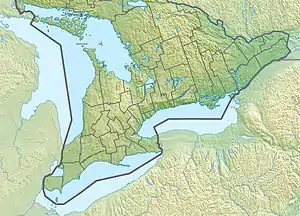| Nottawasaga Bay | |
|---|---|
 Rocky shore on Nottawasaga Bay near Lafontaine | |
 Nottawasaga Bay | |
| Coordinates | 44°40′02″N 80°18′22″W / 44.66722°N 80.30611°W |
| Basin countries | Canada |
| Settlements | Collingwood The Blue Mountains Meaford Tiny Wasaga Beach |
Nottawasaga Bay is a sub-bay within Georgian Bay in Southern Ontario, Canada located at the southernmost end of the main bay.[1] The communities located on Nottawasaga Bay are Meaford, The Blue Mountains, Collingwood, Wasaga Beach and Tiny.
The western shore of Nottawasaga Bay is determined by the Niagara Escarpment, which reaches Nottawasaga Bay between Collingwood and Thornbury. The southern shore is flat limestone plain, with cedar marshes. The Nottawasaga River flows into Georgian Bay near the southern end of the bay, and onward to the east the shore is predominantly sand dunes and marshes created by the strong predominant northwest winds. This part of Nottawasaga Bay is heavily built up with summer homes. Nearer to Thornbury and the Beaver River Valley there are some vineyards; many apple orchards also dot the area.
The river takes its name from the Ojibwe word "Nottawasaga". Nottawa (or Naadowe in modern orthography) means "Iroquois" and saga (zaagi in modern orthography) means "mouth of the river"; the word "Nottawasaga" (Naddowe-zaagi in modern orthography) was used by Algonquin scouts as a warning if they saw Iroquois raiding parties approaching their villages.[2]
Thus, the name of the river, in Ojibwe, is Naadawe-zaagiing, "At the Iroquois River-mouth.[3]
Tributaries
(from west to east)
History
In the early and mid-17th century, Nottawasaga Bay was adjacent to two indigenous First Nations territories: Huronia to the east, which was the territory of the Huron or Wendat people, and the "Petun Country" to the south, which was the land of the Petun, who were their close allies and relatives.[4] In March 1649, during the Beaver Wars, Huron refugees fled across the bay, which was frozen over with ice, to take refuge among the Petun.[5]
References
Citations
- ↑ "Nottawasaga Bay". Geographical Names Data Base. Natural Resources Canada. Retrieved 2014-05-10.
- ↑ "The History of Wasaga Beach" (PDF). Wasagabeach.com. Archived from the original (PDF) on 2014-01-16. Retrieved 2022-02-03.
- ↑ Translate Ojibwe, Ojibwe-English Dictionary
- ↑ McMillan & Yellowhorn 2004, p. 77.
- ↑ Garrad 2014.
Bibliography
- Garrad, Charles (2014). Pilon, Jean-Luc; Fox, William (eds.). Petun to Wyandot: The Ontario Petun from the Sixteenth Century. Mercury Series. University of Ottawa Press. ISBN 978-0-7766-2151-7. JSTOR j.ctt6wr8db.
- McMillan, Alan D.; Yellowhorn, Eldon (2004). First Peoples In Canada (3rd ed.). Douglas & McIntyre. ISBN 1-55365-053-0.
Other map sources:
- Map 4 (PDF) (Map). 1 : 700,000. Official road map of Ontario. Ministry of Transportation of Ontario. 2014. Retrieved May 10, 2014.
- Map 5 (PDF) (Map). 1 : 700,000. Official road map of Ontario. Ministry of Transportation of Ontario. 2014. Retrieved May 10, 2014.
- Watershed Map (PDF) (Map). 1 : 375,000. Nottawasaga Valley Conservation Authority. Archived from the original (PDF) on April 17, 2012. Retrieved May 10, 2014.